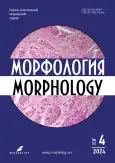Maternal prepregnancy anthropometric measures as a factor influencing neonatal birth weight
- Authors: Iutinsky E.M.1, Zheleznov L.M.1, Dvoryansky S.A.1
-
Affiliations:
- Kirov State Medical University
- Issue: Vol 162, No 4 (2024)
- Pages: 426-434
- Section: Original Study Articles
- Submitted: 01.11.2024
- Accepted: 28.12.2024
- Published: 28.12.2024
- URL: https://j-morphology.com/1026-3543/article/view/640869
- DOI: https://doi.org/10.17816/morph.640869
- ID: 640869
Cite item
Abstract
BACKGROUND: Maternal anthropometric measures before pregnancy are critical factors influencing neonatal birth weight and pregnancy outcomes. Specifically, a low maternal body mass index (BMI) increases the risk of low birth weight, whereas an elevated BMI is associated with fetal macrosomia and delivery complications. Investigating this relationship is essential for developing regional fetal growth standards and improving perinatal outcomes.
AIM: To assess the impact of maternal prepregnancy BMI on neonatal birth weight using regional data from women residing in the Kirov Region.
METHODS: A retrospective observational single-center study was conducted, including 5,161 pregnant women. Participants were categorized into three groups based on their prepregnancy BMI: underweight (<18.5 kg/m²), normal weight (18.5–24.9 kg/m²), and overweight (25.0–29.9 kg/m²). Women with obesity (BMI ≥30 kg/m²) were excluded. Maternal anthropometric data and neonatal birth weight were analyzed. Statistical methods included analysis of variance, Tukey’s test, Pearson correlation analysis, and multiple linear regression.
RESULTS: Significant differences in neonatal birth weight were observed across maternal BMI categories (p < 0.001). Mean birth weight increased with maternal BMI: 3,050 g ± 380 g (underweight), 3,300 g ± 400 g (normal BMI), and 3,550 g ± 420 g (overweight). A moderate positive correlation was found between maternal body weight and neonatal birth weight (r = 0.32; p < 0.001). Multiple linear regression analysis confirmed that both maternal weight and height were significant predictors of neonatal birth weight (p < 0.001).
CONCLUSION: Maternal prepregnancy BMI is a significant determinant of neonatal birth weight. Monitoring and maintaining BMI within the normal range before conception may contribute to improved perinatal outcomes.
Keywords
Full Text
About the authors
Eduard M. Iutinsky
Kirov State Medical University
Author for correspondence.
Email: iutinskiy@ya.ru
ORCID iD: 0000-0001-5641-0269
SPIN-code: 7139-0566
MD, Cand. Sci. (Medicine), Assistant Professor
Russian Federation, 112 K. Marx st, Kirov, 610998Lev M. Zheleznov
Kirov State Medical University
Email: rector@kirovgma.ru
ORCID iD: 0000-0001-8195-0996
SPIN-code: 2107-3507
MD, Dr. Sci. (Medicine), Professor
Russian Federation, 112 K. Marx st, Kirov, 610998Sergey A. Dvoryansky
Kirov State Medical University
Email: Kf1@kirovgma.ru
ORCID iD: 0000-0002-5632-0447
SPIN-code: 1840-2379
MD, Dr. Sci. (Medicine), Professor
Russian Federation, 112 K. Marx st, Kirov, 610998References
- Singh SP. Somatotype and diseases — review. Anthropologist. 2007;3:251–261. doi: 10.1080/09720073.2007.11891008
- Rebato E, Salses I, Rozik J, et al. Analysis of the similarity of brothers and sisters in the components of the anthropometric somatotype. Annals of Human Biology. 2000;27(2):149–161. doi: 10.1080/030144600282262
- Kondakova LI, Mischenko VA, Krayushkin AI. The influence of a women’s somatotype on morphological characteristics of placenta. Fundamental Research. 2009;(6):20–24. EDN: JTKQUM
- Chrishtop VV, Gaivoronsky IV, Zheleznov LM, et al. Influence of constitutional typology on human cell-tissue homeostasis: a review. Morphology. 2023;161(4):77–86. EDN: QFMXZW doi: 10.17816/morph.627409
- Klimov NYu, Vinnik YuYu, Andreychikov AV, Maximov AS. Constitutional approach in studying human diseases at the present stage. Sechenov Medical Journal. 2018;(4):70–77. EDN: VUTIOQ doi: 10.47093/22187332.2018.4.70-77
- Kornetov NA. Clinical anthropology is the methodological basis of a holistic approach in medicine. In: Topical issues and achievements of modern anthropology. Materials of the international scientific conference. Novosibirsk: Sibprint, 2006. P. 52–57. (In Russ.)
- Markova EV, Fefelova VV, Nikolaev VG, Zakharova LB. Constitutional features of human adaptive capabilities. In: Topical issues of biomedical and clinical anthropology. Proceedings of the science conference «Topical issues of biomedical and clinical anthropology». Krasnoyarsk: Krasnoyarsk Medical Academy, 1997. P. 55–57. (In Russ.) EDN: THURFR
- Lin L, Lin J, Yan J. Association of maternal body mass index change with risk of large for gestational age among pregnant women with and without gestational diabetes mellitus: a retrospective cohort study. J Matern Fetal Neonatal Med. 2024;37(1):2316732. EDN: NTATBU doi: 10.1080/14767058.2024.2316732
- Miao J, Chen Y, Liu X, et al. Maternal Body Mass Index, Gestational Weight Gain, and Risk of Cancer in Offspring: A Systematic Review and Meta-Analysis. Nutrients. 2023;15(7):1601. EDN: FWOGLO doi: 10.3390/nu15071601
- Liu P, Xu L, Wang Y, et al. Association between perinatal outcomes and maternal pre-pregnancy body mass index. Obesity Reviews. 2016;17(11):1091–1102. doi: 10.1111/obr.12455
- Usynina AA, Postoev VA, Odland JY, Grzhibovsky AM. Pregnancy outcomin low-weight women. Obstetrics and Gynecology. 2019;12:90–95. EDN: FOEDBJ doi: 10.18565/aig.2019.12.90-95
- Kazankina AS, Ushanova FO. Evaluation of the influence of maternal weight on the course of pregnancy and birth outcomes of fetuses with macrosomia. Endocrinology: News, Opinions, Training. 2023;12(3):20–25. EDN: IZSFOW doi: 10.33029/2304-9529-2023-12-3-20-25
- Gilley SP, Harrall KK, Friedman C, et al. Association of Maternal BMI and Rapid Infant Weight Gain With Childhood Body Size and Composition. Pediatrics. 2023;151(5):e2022059244. doi: 10.1542/peds.2022-059244
Supplementary files








